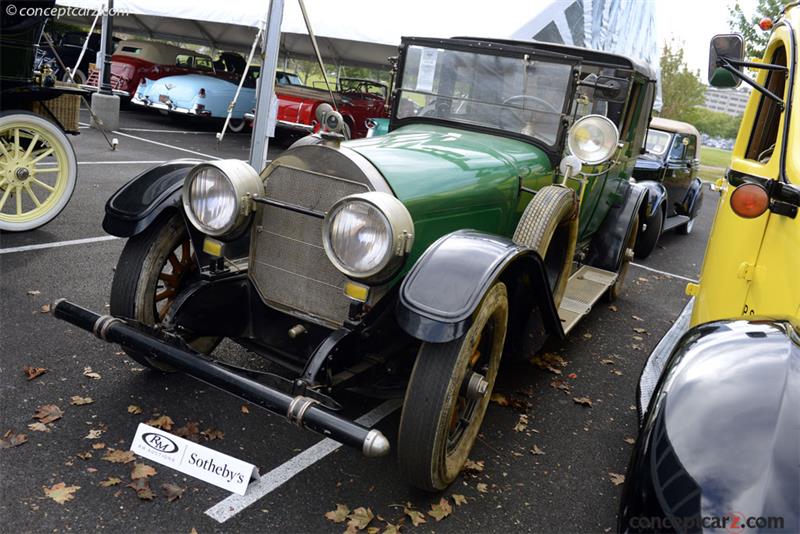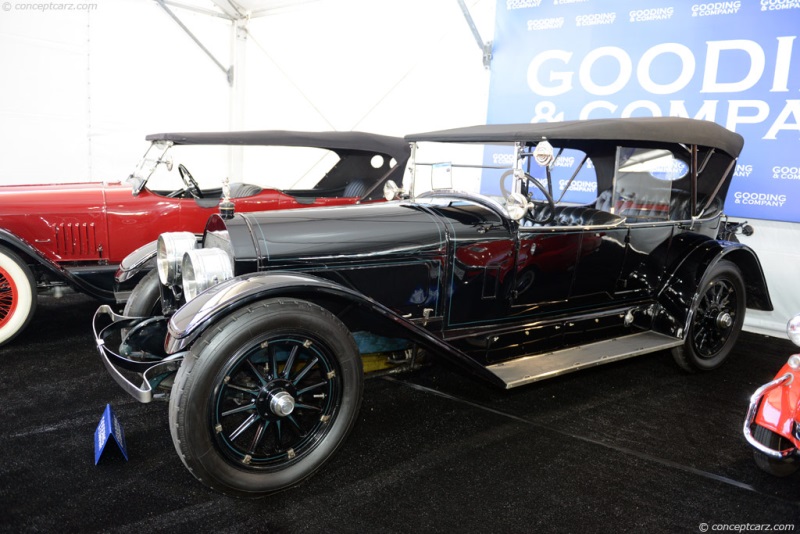History
The name '48' was used by the Locomobile Company to signify their six-cylinder engines that were originally rated at 48 horsepower. The first Model 48 was introduced in 1911 and remained in production until 1924. At this point, horsepower had skyrocketed to just over 100. When it was first introduced, it was a marvel both aesthetically and mechanically. By the mid-1920s, it had begun to show its age. Sales reflected, and as a result, the company was forced to increase its price.
During the mid-1910s, the Company experimented with custom coachwork to appeal to wealthy clients. The vehicles were built to customer specifications and created to satisfy their needs and desires. The use of accessories by Tiffany Studios was not uncommon for the Locomobile Company at this time.
By Daniel Vaughan | Oct 2007
During the mid-1910s, the Company experimented with custom coachwork to appeal to wealthy clients. The vehicles were built to customer specifications and created to satisfy their needs and desires. The use of accessories by Tiffany Studios was not uncommon for the Locomobile Company at this time.
By Daniel Vaughan | Oct 2007
Owned by elite members of upper East Coast aristocracy like Vanderbilt, Wanamaker, Melon, Gould, and Governor Cox of Massachusetts, and prestigious members of the West like Tom Mix, Charlie Chaplin, and Cecil B. DeMille, the Locomobile Model 48 was one of the most expensive and elegant automobiles ever manufactured in the United States. Weighing 3 tons, the six-cylinder Model 48 came arrived on the scene in 1911 and became known as the 'Best Built Car in America'. During its eight-year production run, the most famous Locomobile was originally priced at $4,800, which would eventually rise to $9,600. By 1923 the Model 48, advertised as the 'The Exclusive Car for Exclusive People' was in such demand that the automobile was produced at a rate of two per day.
Locomobile began its story as a manufacturer of inexpensive light steam carriages before it began building gasoline-powered automobiles. By 1904 the company had transformed itself into a luxury brand and experimented with custom coachwork in an attempt to appeal to a wealthy clientele. The automobiles were built to exact customer specifications, and the accessories came from Tiffany Studios.
Locomobile found itself trying to reinstate itself in the premier auto market once again in 1921 after a new board of directors seated themselves at the helm. At the Bridgeport plant, using overstocked parts, the Model 48 was assembled with engineer Andrew Lawrence Riker making mechanical improvements. Unfortunately for the Locomobile Company, Riker left the company in 1921.
The Locomobile Company named the Series 8 Model '48' to signify their six-cylinder engines that were originally rated at 48 horsepower. Introduced in 1911, the '48' would continue in production until 1924 and was constructed of magnesium bronze, aluminum, and steel. The wheelbase of the Model 48 was nearly 30 inches longer than that of a modern Chevy Suburban. Many of the powertrain components were cast in bronze, while the chassis was constructed of chrome-nickel steel. The Model 48 would be one of the few luxury automobiles whose production period would span the brass, nickel, and chrome eras. It was an expensive, old-fashioned vehicle for wealthy, conservative, old-fashioned people.
Featuring balloon tires, the 48 sported Buffalo wire wheels, and nickel-plated or brass trim. Most Locomobiles featured two spares and the option of two-wheel drum brakes or four-wheel brakes. Demarest was responsible for the body of the Model 48 and was something not often seen – a six-fendered car with the fifth and six fenders sitting just in front of the rear passenger compartment. At first, the Model 48 was met with fanfare and popularity, but before long the basic design of the car, even with numerous mechanical improvements, was an outdated design. Horsepower dwindled down to just over 100, and sales of the basically unchanged Model 48 continued through 1932 and 1924, still using 1919 parts. Late in 1924 the new Model 48 was debuted; the 19,000 Series. Though it was basically the same car, the 19000 Series sold for $2,000 less.
The following year the Model 48 was officially discontinued and replaced with the Model 90, a new luxury automobile. Unfortunately, many coachbuilt-bodied Locomobiles were made into scrap metal during World War II. Today there are approximately 167 Model 48's known to exist and are considered wonderful historic examples of a bygone era. Valuable and extremely collectible, the Locomobile Model 48 was a truly exceptional automobile.
Sources:
http://www.locomobilesociety.com/history.cfm
http://www.hemmings.com/hcc/stories/2005/03/01/hmn_feature17.html
http://www.classiccarweekly.net/2012/06/01/locomobile-model-48/
By Jessica Donaldson
Locomobile began its story as a manufacturer of inexpensive light steam carriages before it began building gasoline-powered automobiles. By 1904 the company had transformed itself into a luxury brand and experimented with custom coachwork in an attempt to appeal to a wealthy clientele. The automobiles were built to exact customer specifications, and the accessories came from Tiffany Studios.
Locomobile found itself trying to reinstate itself in the premier auto market once again in 1921 after a new board of directors seated themselves at the helm. At the Bridgeport plant, using overstocked parts, the Model 48 was assembled with engineer Andrew Lawrence Riker making mechanical improvements. Unfortunately for the Locomobile Company, Riker left the company in 1921.
The Locomobile Company named the Series 8 Model '48' to signify their six-cylinder engines that were originally rated at 48 horsepower. Introduced in 1911, the '48' would continue in production until 1924 and was constructed of magnesium bronze, aluminum, and steel. The wheelbase of the Model 48 was nearly 30 inches longer than that of a modern Chevy Suburban. Many of the powertrain components were cast in bronze, while the chassis was constructed of chrome-nickel steel. The Model 48 would be one of the few luxury automobiles whose production period would span the brass, nickel, and chrome eras. It was an expensive, old-fashioned vehicle for wealthy, conservative, old-fashioned people.
Featuring balloon tires, the 48 sported Buffalo wire wheels, and nickel-plated or brass trim. Most Locomobiles featured two spares and the option of two-wheel drum brakes or four-wheel brakes. Demarest was responsible for the body of the Model 48 and was something not often seen – a six-fendered car with the fifth and six fenders sitting just in front of the rear passenger compartment. At first, the Model 48 was met with fanfare and popularity, but before long the basic design of the car, even with numerous mechanical improvements, was an outdated design. Horsepower dwindled down to just over 100, and sales of the basically unchanged Model 48 continued through 1932 and 1924, still using 1919 parts. Late in 1924 the new Model 48 was debuted; the 19,000 Series. Though it was basically the same car, the 19000 Series sold for $2,000 less.
The following year the Model 48 was officially discontinued and replaced with the Model 90, a new luxury automobile. Unfortunately, many coachbuilt-bodied Locomobiles were made into scrap metal during World War II. Today there are approximately 167 Model 48's known to exist and are considered wonderful historic examples of a bygone era. Valuable and extremely collectible, the Locomobile Model 48 was a truly exceptional automobile.
Sources:
http://www.locomobilesociety.com/history.cfm
http://www.hemmings.com/hcc/stories/2005/03/01/hmn_feature17.html
http://www.classiccarweekly.net/2012/06/01/locomobile-model-48/
By Jessica Donaldson
Locomobile
Similar Automakers
Similarly Priced Vehicles
1920 Locomobile Model 48 Vehicle Profiles
Recent Vehicle Additions
Performance and Specification Comparison
Price Comparison
Model 48 Specification Comparison by Year
Year
Production
Wheelbase
Engine
Prices
Related Automotive News
Resta-ssured: 1916 Indianapolis 300
The moment Dario Resta arrived in the United States from England he would be immediately successful in such races as the Vanderbilt Cup and other regional events. At the time, the sport of motor racing would be a fledgling proposition that would rely...
HILTON HEAD ISLAND MOTORING FESTIVAL & CONCOURS D'ELEGANCE ANNOUNCES EXPANSION OF 2014 SAVANNAH SPEED CLASSIC
Celebrating a decade of vintage racing, the Savannah Speed Classic boasts exciting additions, brings racing back to its roots
HILTON HEAD ISLAND, S.C. – The Hilton Head Island Motoring Festival %26 Concours dElegance (HHIMF), one of the...

Historic Horsepower Reigns at The Elegance at Hershey
Hershey, PA (April 16, 2014) – The Elegance at Hershey, known for its garden-party setting showcasing some of the worlds rarest and most beautiful cars ever produced, will once again feature a stunning array of vintage high-performance and highly-collectible...

Gooding & Company Amelia Island Auction Preview
Gooding %26 Company, the auction house acclaimed for selling the worlds most significant and valuable collector cars, will hold its annual Amelia Island Auction on Friday, March 7 on the Omni Amelia Island Plantation.
David Gooding, President and founder...

Prince Heinrich Benz Racers Reunited at 'The Amelia'
In the early 1900s, at the dawn of the automotive motorsport age, one of the most significant race venues was the Prinz Heinrich Tour, named after Prince Albert Wilhelm Heinrich of Prussia, automotive enthusiast and brother of German Emperor Wilhelm...























